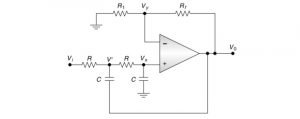- Definition of an active LPF
- What does an active LPF do?
- Components of an active LPF
- Frequency Response
- Design active LPF
- Frequency scaling
- Transfer Function
- What is a second-order LPF
- The transfer function of second-order active LPF
- Design a second-order active LPF
- Comparison between active low-pass and passive low-pass filter
- Why do we use active LPF
- Advantages of an active LPF
- FAQs
What is an Active Low Pass Filter?
First things first, let’s discuss what a simple Low Pass Filter is-
“Low Pass Filter is a type of filter which mainly passes signals with a frequency lower than the particular cut-off frequency and attenuates all the frequency higher than the cut-off range ”.
Now, an Active Low Pass Filter is made of active components like Op-amp, resistors, and it also carries lower frequency signals with less resistance and has a constant output gain from zero to a cut-off frequency.
Components of Low Pass Active Filter:
Active filters consist of active components as the name implies such as Operational amplifier, transistors or FET within the circuitry.
An active filter typically consists of amplifiers, capacitors and resistances.
So generally, Low Pass Active Filter is any filter using an Op-amp to improve the performance and predictability in such a low cost.
How does an Active Low Pass Filter work

In the above figure, it’s a commonly used low pass active filter.
Frequency Response of Low Pass Filter:

Active Low Pass Filter Design:
Resistance R =

Fc = cut-off frequency
Ωc = cut-off frequency
C = capacitance

A cut-off frequency can be varied by multiplying it with RC or C.

Transfer Function of a First Order Active Low Pass Filter:
Differential Equation for the filter –

Second-Order Active LPF:
What is a second-order LPFs?
To build a second-order filter, we usually use an op-amp, and therefore the second-order filter can also be called as a VCVS filter; where VCVS is referred to ‘Voltage Control Voltage Source’ amplifier. We design a second-order filter along with a first-order active RC filter.
As it is a low pass filter, it only allows the lower frequency signals to pass, and it attenuates all the higher frequencies above the specified frequency range.
A second-order low pass filter attenuates the higher frequency signals more precisely. The gain reduces at the rate of 12 dB per octave. In other way it is 40 dB/decade.

In a second order filter,

When the resistor and capacitor values are different,

When the resistor and capacitor values are same,

Transfer Function of a Second Order Active Low Pass filter:
The Transfer Function is denoted as,

The magnitude of the Transfer function –

Where ωc is the cut-off frequency.
Frequency-responses of second-order low-pass active filters is given.

Design of a second-order active low pass filter
First, we choose a value of the cut-off frequency, ωc (or fc).
Find R,

- Rf comes as –
Rf = K(2R) = 3.172 R.
- Find R1 while K = 1.586

Differences between Active Low Pass Filter & Passive Low Pass Filter:
- Active components are effectively costlier, that’s why the active filters are expensive as well, whereas the cost of passive filters is lower due to the presence of the passive components.
- Active Low Pass filter circuit is a complex one, while a passive low pass filter circuit has less complexity.
- To operate an active LPF, we need an external power supply for operating it. But passive filters do not require external power because it drives the energy for its operation from the applied input signal.
- Passive filters contain more components than an active low pass filter; that’s why they are heavier in weight.
- Active LPF is more sensitive during temperature change, but the passive ones show less sensitivity with the growth of temperature.
Why to use Active LPF?
Due to the less complex circuitry and lower price than the other active filters, we use Active LPF in many fields.
Check out them here – Low Pass Filter Applications.
- Low pass filter is used in ‘hiss’ filters.
- These filters are also used in ADCs. They act as anti-aliasing filter in that circuits.
- LPFs are also used to prevent the harmonic emissions from the RF transmitters.
- These filters find applications in the music systems also. There these filters omits the high-frequency components.
Advantages of an Active Low Pass filter:
- For a transfer function with inductive characteristics, it can achieve satisfactory output with an acceptable range of frequencies.
- The high input impedance and low output impedance of the op-amp make the circuit excellent while cascading.
- Due to better amplification, it provides more gain.
What is 3db frequency in an active low pass filter?
3db is the power level, where the cut-off frequency is at 3dB below than the maximum value, and 3dB is usually half of the maximum power.
To read more about electronics click here

Hi, I am Soumali Bhattacharya. I have done Master’s in Electronics.
I am currently invested in the field of Electronics and communication.
My articles are focused on the major areas of core electronics in a very simple yet informative approach.
I am a vivid learner and try to keep myself updated with all the latest technologies in the field of Electronics domains.
Let’s connect through LinkedIn –